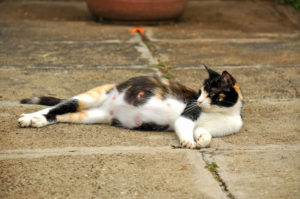Cats can see in far red and ultraviolet wavelengths. This means they can see different colors than humans, who only see the visible spectrum (waves of light that we can perceive with our eyes). A cat’s eye contains cells called rods and cones. Rods detect brightness and color and cones detect color. There are two types of receptors: cones and rods. Cones provide acute vision for daytime activities, such as hunting prey or viewing objects at a distance; rods allow night time vision with an adequate source of light, but don’t provide as vivid images as cones do. The retina is made up rods which contain the photo pigments rhodopsin (visual purple)and iodopsin (visual yellow), which absorb light and turn it into electrical signals.
About cats eyes
The retina of the eye is made up primarily of two types of receptors: rods and cones (glial cells also exist, but they play a secondary role to the photoreceptors). The retina is one of the most important parts of the nervous system; it’s where visual images are formed and relayed from neuron to neuron. Rods are sensitive to light, while cones are responsible for color vision, enabling cats to see in bright daylight as well as in low-light conditions. Humans have three types of cone that allow us to perceive red, green or blue wavelengths of light. Cats have two types, which means they can only see blues and greens. This makes sense because cats are nocturnal hunters, while humans are diurnal (active during the day).
Cone cells function by visual phototransduction which is an optical signal transduction process that occurs in retinal photoreceptor cells. Retina rod and cone cells contain a light-sensitive pigment that converts light into signals that can stimulate neurons of the retina. This photo pigment is called rhodopsin, or visual purple. A pigment found in the cones of cats rods which allows for color vision. Rhodopsin absorbs light most strongly at wavelengths around 500 nm (wavelengths of violet or blue light) but also has absorption bands of varying strengths at all other visible wavelengths (or colors), meaning it is capable of absorbing over 100% of the visible spectrum of light.
Cats have the following types of cones:
– Blue – S-cones, or short wavelengths (approximately 420 nm), sensitive to violet and blue light. This color is used in low-light conditions. They are responsible for cat’s ability to see at night because they are most sensitive to wavelengths found in moonlight.
– Green – M-cones, or medium wavelengths (approximately 530 nm) that are also responsible for night vision because they are most sensitive to greenish light from artificial sources like street lamps, car headlights and electronic displays. This color would allow cats to distinguish between shades of gray more clearly than human eyes can do, making it easier for them make out objects in dim light.
– Red – L-cones, or long wavelengths (approximately 564 nm) in the red portion of the visible spectrum. This color is responsible for cat’s ability to distinguish colors in bright daylight conditions.
Cats have rods in their retina which contain rhodopsin, a photopigment that absorbs light very strongly at one end of the visible spectrum (the violet/blue region). As a result, rods are capable of absorbing over 100% of the visible spectrum of light and cats can’t see objects that emit or reflect these wavelengths; they appear as black to cats. On top of this, because of an absence of short wavelength sensitive cones, ultraviolet light also appears as black to cats. This leaves cats with just two color-sensitive cone cells to perceive any sort of color images, both of which are sensitive to greenish light at short wavelengths. As a result, cats are likely to see the following colors as different shades of gray:
– Cyan – The combination of blue and green appears as cyan to them.
– Magenta – The combination of blue and red appears as magenta to them.
The cat eye retina
The cat eye retina is very similar to the human retina . It contains rods for detecting motion and cones for detecting color. But there are differences in the number of cones between humans and cats, since humans have 3 types of cones (blue, green, red) while cats have only 2 types (blue, green). This is because humans are diurnal (active in the day) while cats are nocturnal (active at night).
A rod only has one pigment and so it can’t distinguish between different colors. A cone however contains three pigments called opsins. Each opsin absorbs a different wavelength of light which means that when looking at a scene we’re getting 3 “channels” through which we perceive color. The human eye has 3 types of cone cells for perceiving color: red, green and blue. Cats have just 2 types: green and blue, which is why they cannot distinguish some colors. Humans see this as purple but to cats it looks like dark gray or black!
The result is that cats can only see things with colors on the blue-green end of the color spectrum. This is why they can’t distinguish between red, orange or yellow objects that are more toward the red end of the spectrum. Even though they might look different to us, cats see them as similarly colored.
Blue – S-cones, or short wavelengths (approximately 420 nm), sensitive to violet and blue light. This color is used in low-light conditions. They are responsible for cat’s ability to see at night because they are most sensitive to wavelengths found in moonlight.
Green – M-cones, or medium wavelengths (approximately 530 nm) that are also responsible for night vision because they are most sensitive to greenish light from artificial sources like street lamps, car headlights and electronic displays. This color would allow cats to distinguish between shades of gray more clearly than human eyes can do, making it easier for them make out objects in dim light.
Red – L-cones, or long wavelengths (approximately 564 nm) in the red portion of the visible spectrum. This color is responsible for cat’s ability to distinguish colors in bright daylight conditions.





